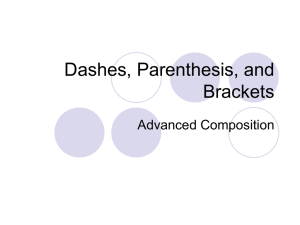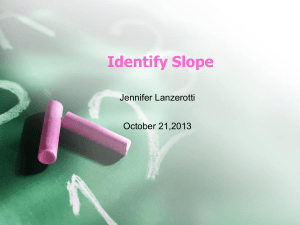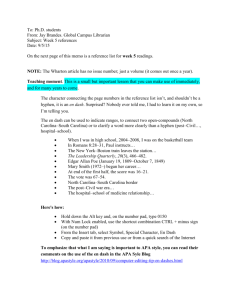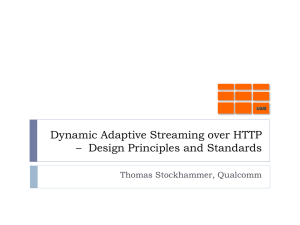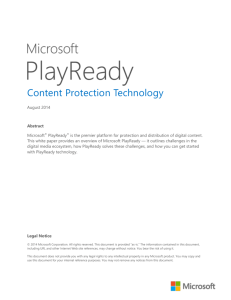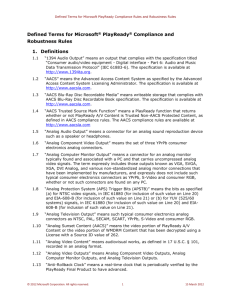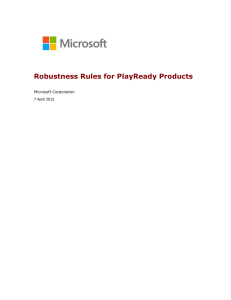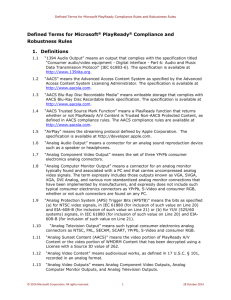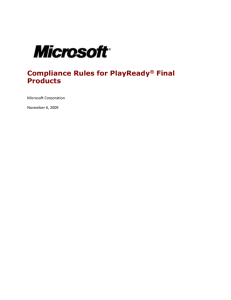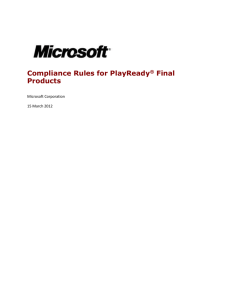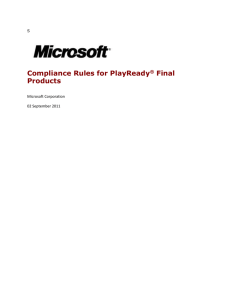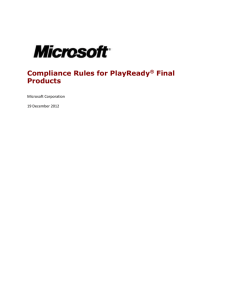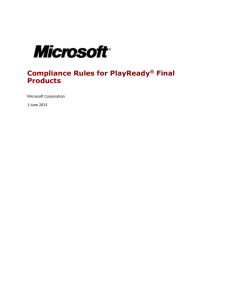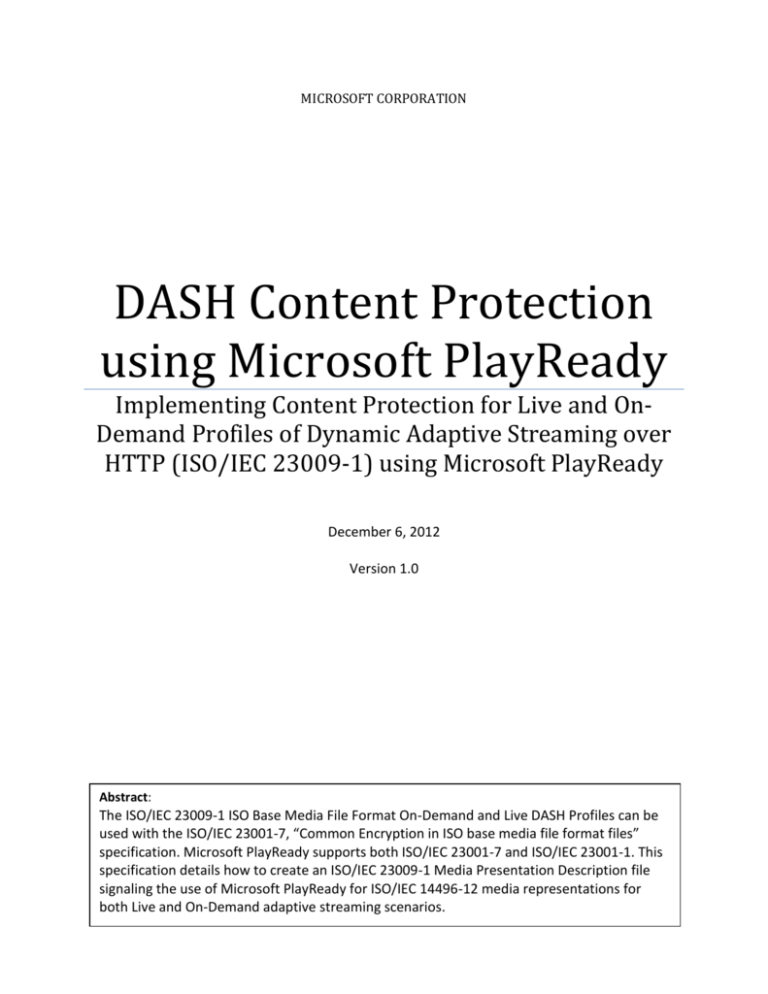
MICROSOFT CORPORATION
DASH Content Protection
using Microsoft PlayReady
Implementing Content Protection for Live and OnDemand Profiles of Dynamic Adaptive Streaming over
HTTP (ISO/IEC 23009-1) using Microsoft PlayReady
December 6, 2012
Version 1.0
Abstract:
The ISO/IEC 23009-1 ISO Base Media File Format On-Demand and Live DASH Profiles can be
used with the ISO/IEC 23001-7, “Common Encryption in ISO base media file format files”
specification. Microsoft PlayReady supports both ISO/IEC 23001-7 and ISO/IEC 23001-1. This
specification details how to create an ISO/IEC 23009-1 Media Presentation Description file
signaling the use of Microsoft PlayReady for ISO/IEC 14496-12 media representations for
both Live and On-Demand adaptive streaming scenarios.
Legal Notice
© 2012 Microsoft Corporation. All rights reserved. This document is provided "as-is." The Information
contained in this document, including URL and other Internet Web site references, may change without
notice. You bear the risk of using it.
This document does not provide you with any legal rights to any intellectual property in any Microsoft
product. You may copy and use this document for your internal, reference purposes. You may not
remove any notices from this document.
6-Dec-12/1.0
i
Contents
1
Introduction ............................................................................. 1
1.1
1.2
1.3
1.4
Scope ......................................................................................................................... 1
Conventions ............................................................................................................. 1
Terminology, Abbreviations and Acronyms ...................................................... 2
References ................................................................................................................ 4
2
PlayReady DASH Content Protection Scheme ....................... 5
3
Media Presentation Description Example ............................ 10
2.1
2.2
3.1
3.2
The ContentProtection Element .......................................................................... 5
Implementation Recommendations and Requirements ................................... 8
Correct PRO in Initialization Segment or Media Content ............................. 10
Including a PlayReady header Object in the MPD.......................................... 11
Tables
Table 1 – Track Encryption Box Components................................................................................ 7
6-Dec-12/1.0
ii
6-Dec-12/1.0
iii
DA S H C O N T E N T P R O T E C T I O N
U S I N G M I C R O S O F T P L A Y R E A DY
VERSION 1.0
DECEMBER 6, 2012
1
INTRODUCTION
The Dynamic Adaptive Streaming over HTTP standard [DASH] specifies formats for the delivery
of media content from HTTP servers to HTTP clients. In DASH the presentation of media content
is described by a Media Presentation Description (MPD) file. The MPD provides resource
identifiers for Segments along with context for these resources within a Media Presentation.
In DASH a Media Presentation consists of a time sequence of Periods ([DASH], section 5.3.2).
Within a Period, media content is arranged into a set of interchangeable encoded versions
called Adaptation Sets ([DASH], section 5.3.3). Each Adaptation Set consists of Representations
([DASH], section 5.3.5) - deliverable encoded versions of the media content components.
A ContentProtection element may be associated with an Adaptation Set or a Representation
([DASH], section 5.8.4.1).
1.1 SCOPE
How to use Microsoft PlayReady as the Content Protection scheme in an ISO/IEC 23009-1 DASH
Media Presentation Description file.
1.2 CONVENTIONS
The key words “MUST”, “MUST NOT”, “REQUIRED”, “SHALL”, “SHALL NOT”, “SHOULD”,
“SHOULD NOT”, “RECOMMENDED”, “MAY”, and “OPTIONAL” in this document are to be
interpreted as described in [RFC2119]. That is:
“MUST”, “REQUIRED” and “SHALL” mean that the definition is an absolute requirement
of the specification.
“MUST NOT” and “SHALL NOT” mean that the definition is an absolute prohibition of
the specification.
“SHOULD” and “RECOMMENDED” mean that there may be valid reasons to ignore a
particular item, but the full implications must be understood and carefully weighed
before choosing a different course.
6-Dec-12/1.0
1
DASH Content Protection using Microsoft PlayReady
1.3
“SHOULD NOT” and “NOT RECOMMENDED” mean that there may be valid reasons when
the particular behavior is acceptable, but the full implications should be understood and
the case carefully weighed before implementing any behavior described with this label.
“MAY” and “OPTIONAL” means the item is truly optional.
TERMINOLOGY, ABBREVIATIONS AND ACRONYMS
1.3.1 TERMINOLOGY
Adaptation Set
In DASH, a set of interchangeable encoded versions of one
or several media content components.
Content Protection (CP)
The process of securing a Protected Resource subsequent to
its delivery to a Client device.
Embedded License
A License stored in the PlayReady header Object.
Embedded License Store
(ELS)
A record in the PlayReady header Object for storing
Embedded Licenses.
Globally Unique
Identifier (GUID)
A unique reference number, represented as a 32-character
hexadecimal string, and usually stored as a 128-bit integer.
Initialization Segment
A DASH Segment containing metadata necessary to present
the media streams encapsulated in Media Segments
Key Identifier (KID)
A GUID which uniquely identifies a key protecting content,
licenses or other sensitive information.
Key Rotation
Periodic changes to the encryption key associated with
media. Typically this means
Leaf License
A license whose content key is encrypted using a content
key in a Root License.
License
A PlayReady data structure that includes policies and an
encrypted content key.
License Acquisition URL
(LAURL)
The License Acquisition PlayReady web service URL.
License Chain
A License Chain consists of a Root License and a Leaf
License. A Leaf License may have multiple Root Licenses and
a Root License may have multiple Leaf Licenses. A License
Chain exists for each pair.
Live Profile
The ISO Base media file format live profile (see section 8.4
of [DASH]). The Live Profile is optimized for live encoding,
where each movie fragment may be requested using a
template generated URL.
6-Dec-12/1.0
2
DASH Content Protection using Microsoft PlayReady
Media Presentation
Collection of data defining a bounded or unbounded
presentation of media content, defined in ISO/IEC 23009-1.
Media Presentation
Description (MPD)
Formal description of a Media Presentation defined in
ISO/IEC 23009-1.
Media Segment
A DASH Segment that complies with a media format and
enables playback, perhaps combined with other Media
Segments and/or an Initialization Segment.
Movie box (‘moov’)
In the ISO Base Media File Format, the box whose sub-boxes
define the metadata for a media presentation [ISOBFF].
Movie Fragment box
(‘moof’)
In the ISO Base Media File Format, the Movie Fragment box
extends the media presentation in time [ISOBFF].
On Demand Profile
The ISO Base media file format On Demand profile (see
section 8.3 of [DASH]). The On Demand Profile provides
basic support for On-Demand content. Each Representation
is provided as a single Segment, Subsegments are aligned
across an Adaptation Set’s Representations, and
Subsegments begin with a Stream Access Point.
Period
Interval of a Media Presentation.
PlayReady header Object A binary object containing a variable number of records.
(PRO)
These records contain information related to licenses and
license acquisition.
Protection System
Specific Header box
(‘pssh’)
In the ISO Base Media File Format, the Protection System
Specific Header box contains metadata needed by a specific
Content Protection system to decrypt the media content
[ISOBFF].
Representation
One of the media content component alternative choices
during a defined Period. It is described by an MPD
Representation element ([DASH], section 5.3.5).
Rights Management
Header
A record in the PlayReady header Object containing
metadata needed to decrypt the media content, including a
Key ID and License Acquisition URLs (see [PRHEADER]).
Root License
A License whose content key is used to encrypt a content
key in a Leaf License
Segment
In DASH, a unit of data in an MPD associated with an HTTPURL and optional byte range.
Segment Index
Time range to byte range index mapping within a Media
Segment separate from the MPD.
6-Dec-12/1.0
3
DASH Content Protection using Microsoft PlayReady
Stream Access Point
(SAP)
The position in a Representation which enables Media
Segment playback using only the Representation data from
that position forward.
Subsegment
In DASH, this is a unit within a Media Segment indexed by a
Segment Index.
Track Encryption box
In the ISO Base Media File Format, the Track Encryption box
describes the default encryption parameters for a track
[CENC], [ISOBFF].
Video On Demand (VOD)
System enabling the End-user to select and watch video
content on demand. In the context of this specification, this
means using the DASH On Demand Profile.
1.3.2 ABBREVIATIONS AND ACRONYMS
CP
Content Protection
1.4
DASH
Dynamic Adaptive Streaming over HTTP
ELS
Embedded License Store
GUID
Globally Unique Identifier
KID
Key Identifier
LAURL
License Acquisition URL
MPD
Media Presentation Description
PRO
PlayReady header Object
SAP
Stream Access Point
VOD
Video On Demand
REFERENCES
1.4.1 NORMATIVE REFERENCES
[CENC]
ISO/IEC 23001-7: 2011, “Information technology – MPEG systems
technologies – Part 7: Common encryption in ISO base media file
format files”.
[DASH]
6-Dec-12/1.0
ISO/IEC 23009-1:2012, “Information technology — Dynamic adaptive
streaming over HTTP (DASH) — Part 1: Media presentation description
and segment formats”,
http://standards.iso.org/ittf/PubliclyAvailableStandards/c057623_ISO_
IEC_23009-1_2012.zip
4
DASH Content Protection using Microsoft PlayReady
[PRHEADER]
“Microsoft PlayReady Header Object”,
http://www.microsoft.com/playready/documents/
[RFC2119]
“Key words for use in RFCs to Indicate Requirement Levels”, S. Bradner,
March 1997, http://www.ietf.org/rfc/rfc2119
[RFC3629]
“UTF-8, a transformation format of ISO 10646”, F. Yergeau, November
2003, http://tools.ietf.org/html/rfc3629
[RFC4122]
“A Universally Unique IDentifier (UUID) URN Namespace”, P. Leach, M.
Mealling, R. Salz, July 2005, http://www.ietf.org/rfc/rfc4122.txt
1.4.2 INFORMATIONAL REFERENCES
[ISOBFF]
ISO/IEC 14496-12, Third Edition, “Information technology – Coding of
audio-visual objects – Part 12: ISO Base Media File Format”, with
Corrigendum 1:2008-12-01, Corrigendum 2:2009-05-01, Amendment
1:2009-11-15 and Amendment 3:2011-08-17.
2
PLAYREADY DASH CONTENT PROTECTION SCHEME
Microsoft PlayReady supports the new ISO/IEC 23001-7 [DASH] and ISO/IEC 23001-1 [CENC]
standards. This specification details how to create a DASH Media Presentation Description file
signaling the use of Microsoft PlayReady for ISO Base Media File Format media representations,
for both On Demand ([DASH], section 8.3) and Live ([DASH], section 8.4) adaptive streaming
scenarios.
The four scenarios which are the focus of this specification are VOD or live presentations of
media:
1. encrypted with a single key
2. where some content is encrypted and some content is in the clear
3. with Key Rotation without Embedded Leaf Licenses
4. with Key Rotation with Embedded Leaf Licenses
2.1 THE CONTENTPROTECTION ELEMENT
How you indicate PlayReady Content Protection depends on whether you want to include
PlayReady header object (PRO) and/or Track Encryption box data in the MPD.
6-Dec-12/1.0
5
DASH Content Protection using Microsoft PlayReady
Including the PRO in the MPD will depend on whether:
there is an Initialization Segment associated with the Representation which contains a
PRO in a Protection System Specific Header box (‘pssh’)
the media content streamed to the client contains a ‘pssh’ with a PRO
you wish to override the PRO in either the Initialization Segment or the ‘pssh’ box in the
media content streamed to the client
Including the Track Encryption box data in the MPD will depend on whether:
there is an Initialization Segment associated with the Representation which contains a
Track Encryption Box (‘tenc’)
the media content streamed to the client contains a ’tenc’
you wish to override the ‘tenc’ in either the Initialization Segment or the media content
streamed to the client
2.1.1 CORRECT PRO IN INITIALIZATION SEGMENT OR MEDIA CONTENT
If there is an Initialization Segment containing the correct PRO, or if the media content includes
a PlayReady ‘pssh’ box with the correct PRO, then the following ContentProtection element
MAY be used:
<ContentProtection schemeIdUri="urn:uuid:79f0049a-4098-8642-ab92e65be0885f95"/>
PlayReady supports the Common Encryption [CENC] standard1. When the license acquisition
metadata is captured in the Initialization Segment or the media content ‘pssh’, the following
ContentProtection element will also work. Note this ContentProtection element will work for all
DRMs that support the ‘cenc’ scheme, providing there is an adequate Initialization Segment or
self-initializing media content.
<ContentProtection schemeIdUri="urn:mpeg:dash:mp4protection:2011"
value="cenc"/>
2.1.2 INCLUDING A PLAYREADY HEADER OBJECT IN THE MPD
There are multiple situations where the PlayReady header Object (PRO) [PRHEADER] may need
to be included with the PlayReady ContentProtection element. For example:
A Live Profile where the PlayReady ‘pssh’ box is absent
A Live Profile where the PRO found in the PlayReady ‘pssh’ box needs to be overridden
An On Demand profile where the PlayReady ‘pssh’ box is absent
An On Demand profile where the PRO in the PlayReady ‘pssh’ box needs to be
overridden
The ‘pssh’ box includes a SystemID, a UUID that uniquely identifies the content protection system. The PlayReady
SystemID is 79f0049a-4098-8642-ab92-e65be0885f95, in the required big endian format [RFC4122].
1
6-Dec-12/1.0
6
DASH Content Protection using Microsoft PlayReady
To identify PlayReady as the Content Protection Scheme and include the PRO in the
ContentProtection element, use the following syntax2:
<ContentProtection schemeIdUri="urn:uuid:79f0049a-4098-8642-ab92e65be0885f95">
<mspr:pro><!-- base64-encoded PlayReady object --></mspr:pro>
</ContentProtection>
The following rule MUST be followed when including a PRO in the PlayReady ContentProtection
element:
If the media content contains a PlayReady ‘pssh’ box with a PRO containing a LAURL,
and that LAURL differs from the LAURL in the PRO included in the ContentProtection
element, the ContentProtection element LAURL SHALL take precedence.
2.1.3 INCLUDING TRACK ENCRYPTION BOX COMPONENTS
With the Live Profile, there may be Media Presentation Periods which are unencrypted,
followed by Periods which are encrypted. In addition, the Key Identifier (KID) may change from
Period to Period.
The default setting for this information MAY be encoded in the media content Track Encryption
box (see [ISOBFF] and [CENC]) in an Initialization Segment. Those default settings MAY also be
communicated in the ContentProtection element associated with the Media Presentation
Period’s Adaptation Set.
The parameters can be set in the PlayReady ContentProtection element are given in Table 1
(see section 9.2, [CENC]).
Table 1 – Track Encryption Box Components
Element
Default
Description
IsEncrypted
1
Flag indicating the encryption status of the samples in the sample
group. Allowed values are 0 (not encrypted) and 1 (encrypted).
IV_size
8
The size in bytes of the InitializationVector field. Supported values
are 0, 8 and 16.
If IsEncrypted =1, IV_size MUST NOT be set to 0.
Since not all PlayReady enabled players support 16 byte Initialization
Vectors, it is RECOMMENDED that only an IV_size of 8 be used for
encrypted content.
KID
2
none
16 Byte Key identifier that uniquely identifies the key needed to
decrypt the associated samples.
Throughout this specification ‘mspr’ is ‘urn:microsoft:playready’, defined by xmlns:mspr="urn:microsoft:playready".
6-Dec-12/1.0
7
DASH Content Protection using Microsoft PlayReady
The following rules MUST be followed when including Track Encryption box components in the
PlayReady ContentProtection element:
If a Track Encryption box is included in the protected media, then an IsEncrypted,
IV_size or KID value added to the PlayReady ContentProtection element MUST match
those found in the Track Encryption box.
If mspr:pro is included in the PlayReady ContentProtection element (see section 2.1.2):
-
If a PRO is included in a Protection System Specific Header (‘pssh’) box in the
media content, then the mspr:pro KID MUST match the ‘pssh’ KID.3
-
If there is an Initialization Segment for the Representation which contains a
PlayReady ‘pssh’, then the mspr:pro KID must match the Initialization Segment
KID.
To identify PlayReady as the Content Protection Scheme and include Track Encryption box
components in the MPD, use the following syntax:
<ContentProtection schemeIdUri="urn:uuid:79f0049a-4098-8642-ab92e65be0885f95">
<mspr:IsEncrypted>1</mspr:IsEncrypted>
<mspr:IV_size>8</mspr:IV_size>
<mspr:kid>lFmb2gxg0Cr5bfEnJXgJeA==</mspr:kid>
</ContentProtection>
2.2 IMPLEMENTATION RECOMMENDATIONS AND REQUIREMENTS
The PlayReady header Object (PRO) [PRHEADER] MAY be included in the encoded media
Protection System Specific Header box (‘pssh’) [ISOBFF], the Initialization Segment or encoded
in the MPD itself.
A ‘pssh’ box may be inserted in the Movie box (‘moov’) or the Movie Fragment box (‘moof’).
For example, a ‘pssh’ box may be inserted in the ‘moov’ box to enable the use of Initialization
Segments ([DASH], section 5.3.9.5.2).
2.2.1 GENERAL
The PlayReady ContentProtection element may be associated with Adaptation Sets or their
Representations, but for simplicity it is RECOMMENDED that the PlayReady ContentProtection
element be associated with the Adaptation Set rather than their Representations.
It is RECOMMENDED to include both the PlayReady protection scheme and the DASH MP4
protection scheme with a value of “cenc” in the MPD. This will enable non-PlayReady DRMs
which are “cenc” capable and which have the correct ‘pssh’ in the initialization segment or
media content to decrypt the media. For example:
<ContentProtection schemeIdUri="urn:mpeg:dash:mp4protection:2011"
value="cenc"/>
Note that the format of the Track Encryption Box KID is different that the format of the mspr:pro KID. See [CENC]
and [PRHEADER] for details.
3
6-Dec-12/1.0
8
DASH Content Protection using Microsoft PlayReady
<ContentProtection schemeIdUri="urn:uuid:79f0049a-4098-8642-ab92e65be0885f95"/>
2.2.2 PRECEDENCE OF PRO LOCATION
For the Live and On Demand Profile, when a client application finds a PRO in the MPD, it MUST
take precedence over a PRO contained in the Initialization Segment (see additional Initialization
Segment PRO requirements in 2.2.3).
For the On Demand Profile, if a client application finds a PRO in the MPD, the Rights
Management Header contained in that PRO MUST take precedence over the Rights
Management Header in a PRO contained in a ‘pssh’ box in the ‘moov’ box of the media content.
For the On Demand Profile, if a client application finds a PRO in the Initialization Segment, it
MUST take precedence over a PRO contained in a ‘pssh’ box in the ‘moov’ box header of the
media content (see additional Initialization Segment PRO requirements in 2.2.3).
2.2.3 WHERE TO INCLUDE THE PRO
The Initialization Segment is optional for the On Demand profile. The Initialization Segment is
required for the Live Profile.
A PRO in the Initialization Segment MAY include a Rights Management Header.
Whether using an Initialization Segment or not, it is RECOMMENDED that the MPD include the
correct PRO, so that the Rights Management Header information can be acquired without
acquiring either the Initialization Segment or the Media header from the web.
2.2.4 WHAT TO INCLUDE IN THE MPD PRO
The PRO may include the Rights Management Header and/or an Embedded License Store (ELS).
IT is RECOMMENDED that the MPD PRO include the Rights Management Header.
It is NOT RECOMMENDED to include an ELS unless it is needed as part of a DRM Domain or a
License Chain scheme.
6-Dec-12/1.0
9
DASH Content Protection using Microsoft PlayReady
3
MEDIA PRESENTATION DESCRIPTION EXAMPLE
3.1 CORRECT PRO IN INITIALIZATION SEGMENT OR MEDIA CONTENT
See section 2.1.1 above.
<?xml version="1.0" encoding="utf-8"?>
<MPD
xmlns="urn:mpeg:DASH:schema:MPD:2011"
minBufferTime="PT4.00S"
profiles="urn:mpeg:dash:profile:isoff-live:2011"
type="static">
<Period>
<AdaptationSet mimeType="audio/mp4">
<ContentProtection
schemeIdUri="urn:mpeg:dash:mp4protection:2011"
value="cenc"/>
<ContentProtection schemeIdUri="urn:uuid:79f0049a-40988642-ab92-e65be0885f95">
</ContentProtection>
<Representation bandwidth="134878" id="audio">
<SegmentList duration="4000" timescale="1000">
<Initialization sourceURL="audio/init.mp4"/>
<SegmentURL media="audio/seg-0000.m4f"/>
<SegmentURL media="audio/seg-0001.m4f"/>
<SegmentURL media="audio/seg-0002.m4f"/>
</SegmentList>
</Representation>
</AdaptationSet>
</Period>
</MPD>
6-Dec-12/1.0
10
DASH Content Protection using Microsoft PlayReady
3.2 INCLUDING A PLAYREADY HEADER OBJECT IN THE MPD
See section 2.1.2 above.
<?xml version="1.0" encoding="utf-8"?>
<MPD
xmlns="urn:mpeg:DASH:schema:MPD:2011"
xmlns:mspr="urn:microsoft:playready"
minBufferTime="PT4.00S"
profiles="urn:mpeg:dash:profile:isoff-live:2011"
type="static">
<Period>
<AdaptationSet mimeType="audio/mp4">
<ContentProtection
schemeIdUri="urn:mpeg:dash:mp4protection:2011"
value="cenc"/>
<ContentProtection schemeIdUri="urn:uuid:79f0049a-40988642-ab92-e65be0885f95">
<mspr:pro>6gIAAAEAAQDgAjwAVwBSAE0ASABFAEEARABFAFIAIAB4AG0
AbABuAHMAPQAiAGgAdAB0AHAAOgAvAC8AcwBjAGgAZQBtAGEAcwAuAG0
AaQBjAHIAbwBzAG8AZgB0AC4AYwBvAG0ALwBEAFIATQAvADIAMAAwADc
ALwAwADMALwBQAGwAYQB5AFIAZQBhAGQAeQBIAGUAYQBkAGUAcgAiACA
AdgBlAHIAcwBpAG8AbgA9ACIANAAuADAALgAwAC4AMAAiAD4APABEAEE
AVABBAD4APABQAFIATwBUAEUAQwBUAEkATgBGAE8APgA8AEsARQBZAEw
ARQBOAD4AMQA2ADwALwBLAEUAWQBMAEUATgA+ADwAQQBMAEcASQBEAD4
AQQBFAFMAQwBUAFIAPAAvAEEATABHAEkARAA+ADwALwBQAFIATwBUAEU
AQwBUAEkATgBGAE8APgA8AEsASQBEAD4AUgBBAGgAagBDAHgAZgBMAGE
AawBtAFgAQQBEAGMAQwA0AGQASQArADQAZwA9AD0APAAvAEsASQBEAD4
APABDAEgARQBDAEsAUwBVAE0APgBxAGgASwBXAEgASgBhAEwAMAAxAEk
APQA8AC8AQwBIAEUAQwBLAFMAVQBNAD4APABMAEEAXwBVAFIATAA+AGg
AdAB0AHAAOgAvAC8AcABsAGEAeQByAGUAYQBkAHkALgBkAHkAbgBkAG4
AcwAuAG8AcgBnAC8AYwBvAG4AdABvAHMAbwBzAHMAcAByAC8AcgBpAGc
AaAB0AHMAbQBhAG4AYQBnAGUAcgAuAGEAcwBtAHgAPAAvAEwAQQBfAFU
AUgBMAD4APABEAFMAXwBJAEQAPgBpAEsARwBsAFcARwA0AEQAWABVAHE
ANAB3AGIAVwBnAFIATgBMAFIASgBnAD0APQA8AC8ARABTAF8ASQBEAD4
APAAvAEQAQQBUAEEAPgA8AC8AVwBSAE0ASABFAEEARABFAFIAPgA=</m
spr:pro>
</ContentProtection>
<Representation bandwidth="134878" id="audio">
<SegmentList duration="4000" timescale="1000">
<Initialization sourceURL="audio/init.mp4"/>
<SegmentURL media="audio/seg-0000.m4f"/>
<SegmentURL media="audio/seg-0001.m4f"/>
<SegmentURL media="audio/seg-0002.m4f"/>
</SegmentList>
</Representation>
</AdaptationSet>
</Period>
</MPD>
6-Dec-12/1.0
11

